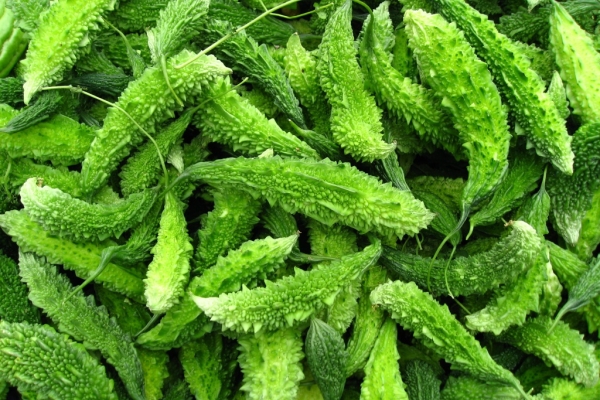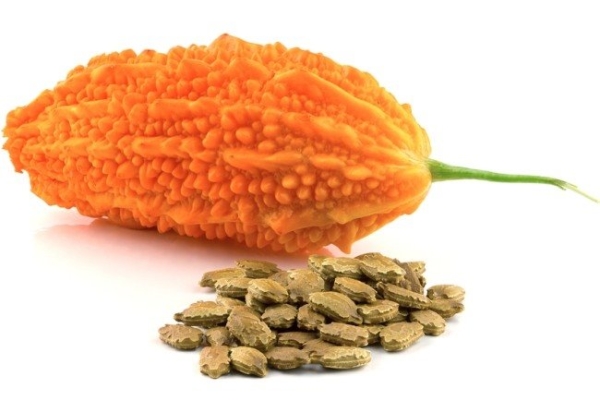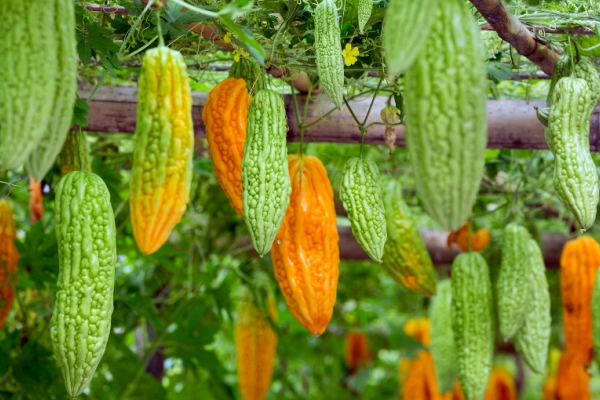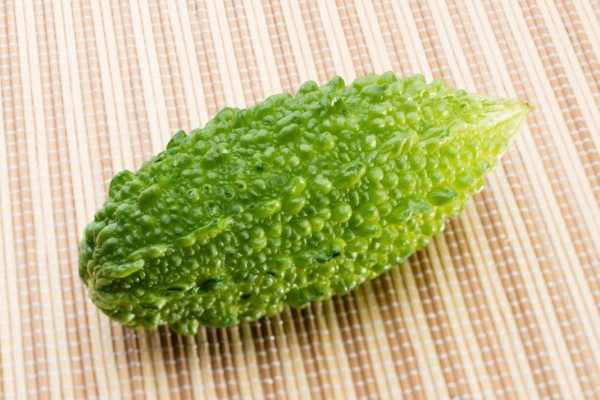Momordica (Indian cucumber) is a tropical plantwhich combines the qualities of cucumber, pumpkin and pomegranate. It has a pleasant taste and contains a large number of nutrients. Its regular use helps to improve the condition.
Table of contents
General characteristics of the plant
Momordica refers to the pumpkin plants. The fruits are oblong.
Initially, the plant was grown in Asia, Africa, Australia. Known information about breeding momordiki in the Crimea. In Russia, the plant appeared not so long ago. It is actively grown in greenhouses, on balconies, and window sills.
Momordica - climbing plant in the form of vines. It is distinguished by its decorative beauty. Creepers reach 2 meters, the leaves are large. During flowering, a large bright yellow flower with a pleasant aroma appears.
Fruits reach 25 centimeters. They have an oval, slightly oblong shape. On the upper part are specific growths.
In its ripe state, the rind of the fruit changes its shade to yellow or orange.. The flesh is juicy, has a ruby color. After maturation occurs cracking of the fetus at the bottom and its disclosure.
What is momordika:
The benefits and properties of momordiki
Indian cucumber has become very popular due to its medicinal properties. Experts note the content in the plant of the three main groups of compounds:
- insulin-like peptides;
- alkaloids;
- carotene.
Indian cucumber is used for medicinal purposes in several areas:
- Normalization of pressure, decrease in blood sugar, treatment of tumor formations. To stabilize the pressure and normalize the overall health of diabetics allows a high content of peptides, alkaloids and carotene.
- Diseases of the gastrointestinal tract and duodenum. The seeds contain a high amount of fats, which allow the treatment of ulcerative diseases.
- Stasis of fluid and bile in the body. Momordica has a diuretic. It allows you to remove excess fluid from the body, helps to clean the choleretic and urinary tract.
- Snake bite treatment. Leaves have pulling properties. They are recommended to apply to the wounds and bites of poisonous snakes. Compress removes toxins from the patient's body, reduces inflammation, reduces pain.

High carotene content, which in the liver turns into vitamin A, has a beneficial effect on the state of vision, hair, nail plates, teeth, and skin.
Thanks to vitamin C, the fruit is used during colds. It is a strong antioxidant.
The use of momordiki allows to improve the permeability of blood vessels, normalize blood clotting, eliminate inflammatory processes in the body.
Contraindications to the use of yellow Indian cucumber
Like most tropical fruits, momordica can cause an allergic reaction.
There are a number of persons that Indian cucumber is contraindicated in:
- Women during pregnancy and lactation. Fruits contain substances that trigger spontaneous abortion.
- Persons prone to allergic reactionssuffering from atopic dermatitis and other manifestations of skin diseases. Indian cucumber is a tropical fruit containing a large amount of acids, oils, vitamin C.It can provoke an allergic reaction.
- Children under 3 years. Young children are not recommended tropical fruits that can cause an allergic reaction.

Use in traditional medicine
For the treatment of folk remedies are actively used all parts of the plant. From them prepare broths, lotions, tinctures and compresses.
Decoction of seeds. For the preparation of the broth will need 250 ml of boiling water and dry seeds of cucumber. The broth is brought to a boil and kept on the fire for 15 minutes.
The tool effectively helps with hemorrhoids, prostatitis, fever. It is used to improve vision.
Fresh seeds. Eating seeds helps to improve the work of the stomach, intestines. Enough once a day, chew 2-3 seeds.
Roots and fruits. From the dried momordiki prepare decoctions and tinctures. They have proven themselves in the treatment of cough during colds.
Fresh leaves. Fresh leaves are used to make decoctions and inhalations. In the case of arthritis from the green shoots preparing a decoction. It helps to relieve pain.
Pulp and juice of fruits. The pulp attached to the bites in the form of compresses allows you to relieve inflammation, remove itching, reduce swelling. Juice is used for compresses with burns of varying degrees.
Overripe fruits have bitterness. Seeds on the contrary should be used only ripened.
The healing properties of momordica:
Use during pregnancy and lactation
During pregnancy and lactation, fruits, seeds or leaves of Indian cucumber prohibited to use. In women at any time, momordica can provoke spontaneous abortion.
The substances contained in the fruit pulp, get into the milk and contribute to the appearance of an allergic reaction in the child. Therefore momordika not recommended for breastfeeding.
Features agrotehnika
Indian cucumber propagated by seeds. For successful germination, it is necessary to destroy the upper shell and soak the seeds in a solution of manganese.
Germinated seeds are planted in separate pots with ready-made soil. In each container is placed 2 seeds. Deepening produce no more than 1.5 centimeters.
Top landing sprinkled with a layer of earth. Before the emergence of seedlings pots closed with a film.

Momordica is a light-loving plant. Shoots need a lot of sunlight. Therefore, the landing is placed on the southern window-sill or make more light in the morning and evening hours.
Pits for seedlings are prepared at a depth of 40 centimeters at a distance of 60 centimeters from each other. Creepers require thorough garters. For support use trellis.
During the care adhere to a number of recommendations:
- plants love abundant, but timely watering. An excessive amount of moisture helps to root the roots;
- cucumber leaves are sprayed with warm water in the evening;
- during the flowering period, fertilizing with mineral fertilizers or a solution of mullein is required;
- Indian cucumber yield can be increased by removing the side shoots after the appearance of the first ovary;
- with a low ovary, plants require artificial pollination;
- Use gloves and skin protection when taking care of plants.

Fruit harvesting occurs 2 weeks after the formation of vines.. Do not leave the crop on the plant, it leads to its weakening.
At observance of recommendations dilution of momordika is not difficult.
